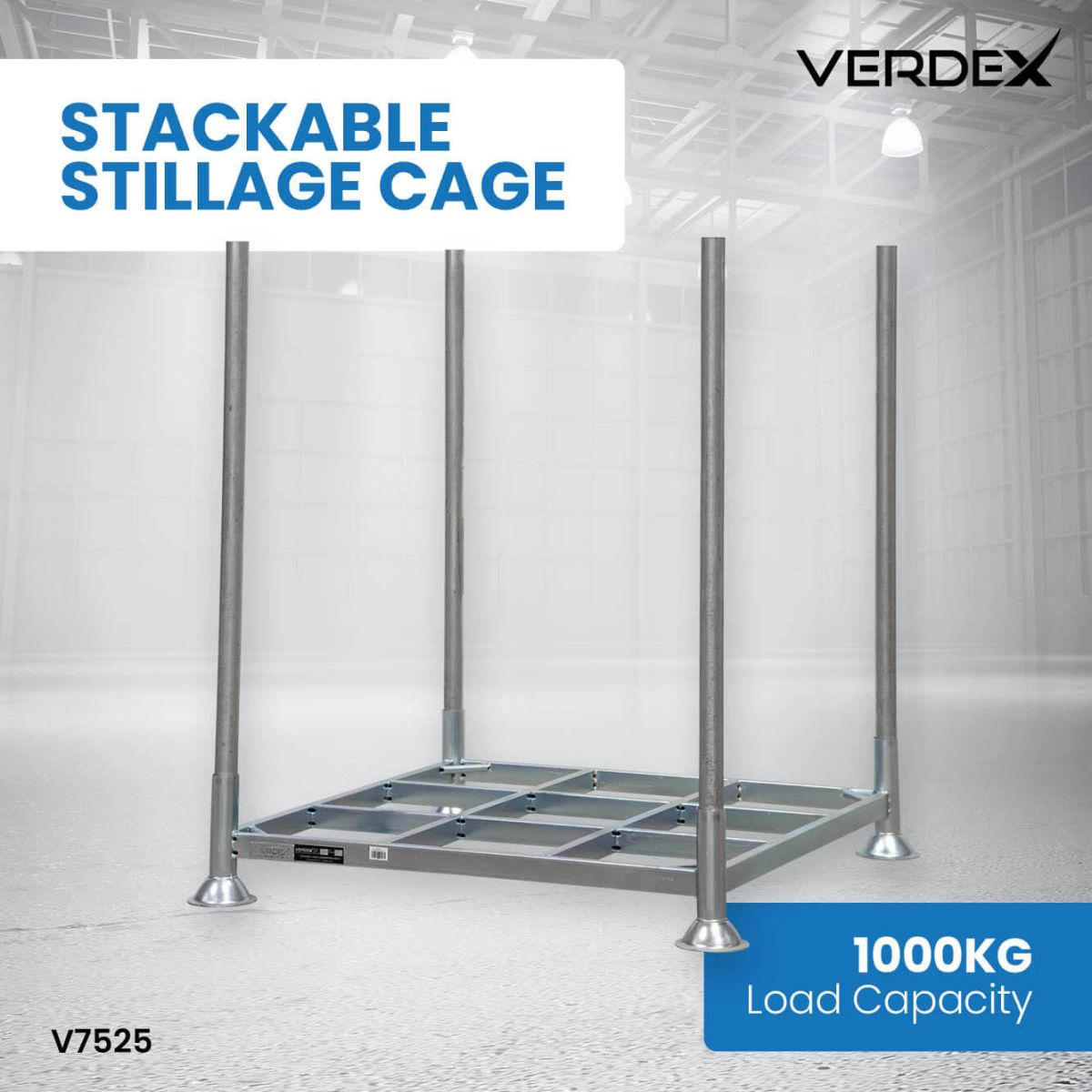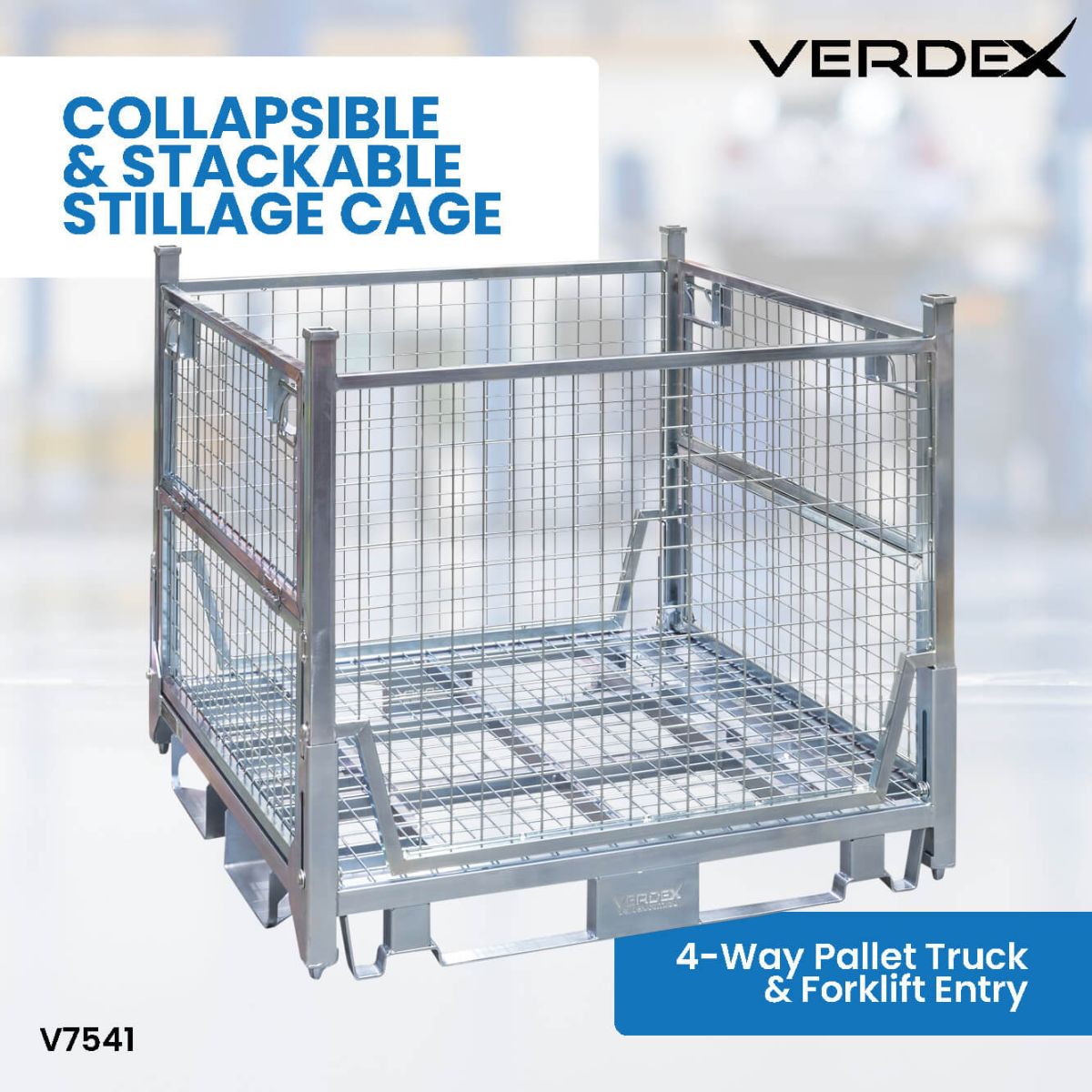What Are Stillage Cages and How Are They Used?
Date Posted:21 October 2025
From warehouses to construction sites, stillage cages are transforming storage and handling efficiency. Find out how they help businesses work smarter and safer every day.
Verdex Insights: At a Glance
-
The Challenge: Many warehouses, factories, and worksites lose time and space managing bulk goods with inefficient or unsafe storage methods.
-
The Insight: Stillage cages provide a secure, stackable, and space-efficient solution that improves handling, organisation, and workplace safety.
-
The Verdex Solution: Verdex supplies durable, high-capacity stillage cages trusted across warehousing, logistics, construction and manufacturing industries, helping Australian businesses optimise storage, protect goods, and boost operational efficiency.
What Are Stillage Cages and How Are They Used?
In modern warehouses, factories, and logistics operations, efficient storage and transportation of goods are essential. One solution that has gained widespread use across various industries is stillage cages. These versatile, sturdy storage units have become crucial for handling goods safely, securely, and efficiently. In this comprehensive guide, we’ll explore what stillage cages are, their uses, benefits, and how they can enhance productivity in your operations.
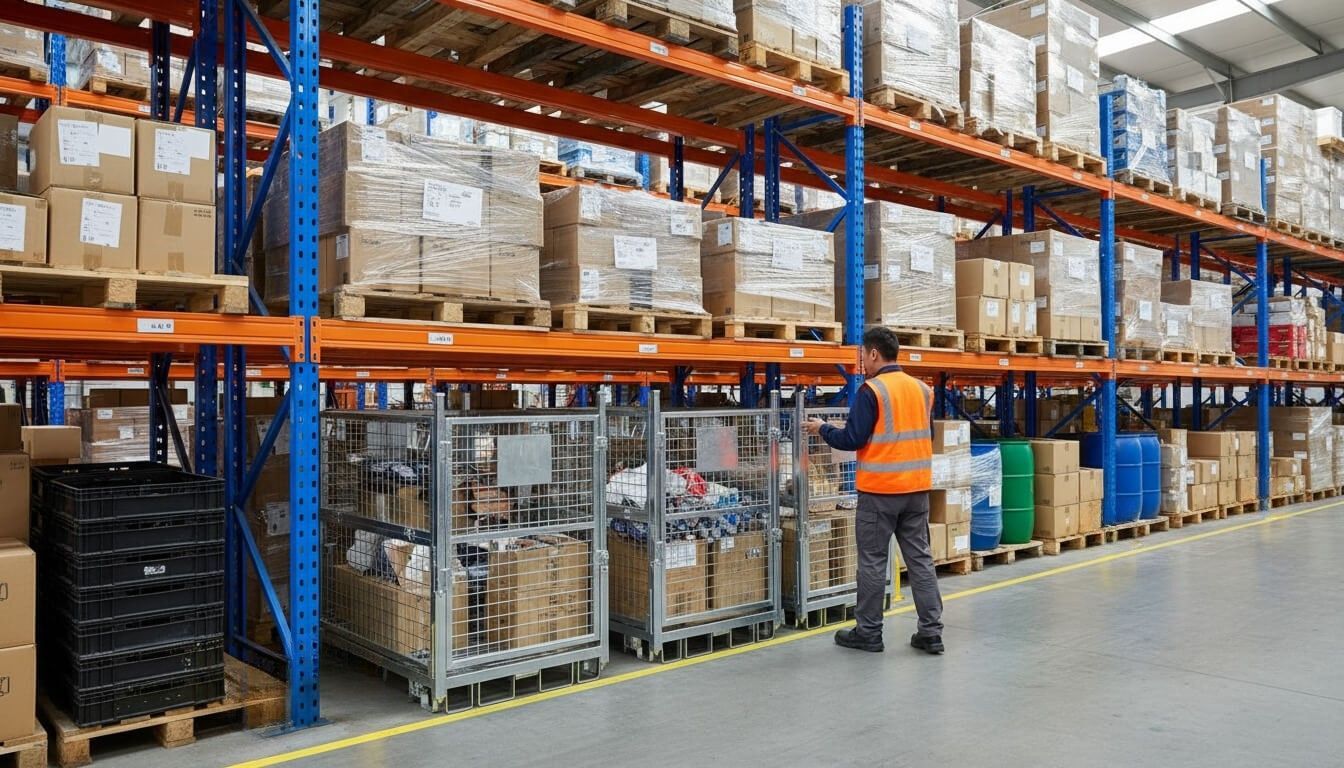 Rectangular Collapsible & Stackable Stillage Cages↗ positioned under pallet racking inside a warehouse.
Rectangular Collapsible & Stackable Stillage Cages↗ positioned under pallet racking inside a warehouse.
.jpg) V7561: Collapsible & Stackable Stillage Cage (Rectangular) ↗
V7561: Collapsible & Stackable Stillage Cage (Rectangular) ↗
What Are Stillage Cages?
A stillage cage, also known as a storage cage, is a type of open-frame container designed for the safe storage, handling, and transportation of goods. Typically constructed from steel or wire mesh, these cages are designed to withstand heavy loads while maintaining flexibility in their design. They often feature foldable sides for easy storage when not in use, and some are equipped with castor wheels for mobility, making them easy to move around warehouses or production floors.
Stillage cages are used to store items in bulk, such as industrial parts, raw materials, finished products, or even food and pharmaceutical goods, depending on the application. Their open-frame design allows for visibility and ventilation, which is particularly beneficial for items that need airflow during storage.
The Main Types of Stillage Cages
There are various types of stillage cages, each designed to meet specific needs within different industries. Some of the common types include:
Standard Stillage Cages
These are the most basic design, often used for general storage and transportation of goods. They provide a simple yet effective way of securing items while allowing easy access to their contents.
Foldable Stillage Cages
These cages are designed with foldable sides, allowing for more compact storage when not in use. They are particularly useful for businesses that require a flexible, space-saving solution for storing or transporting goods.
Stackable Stillage Cages
These are designed to be stacked on top of each other, allowing for vertical storage. This feature maximises warehouse space and enhances storage efficiency.
Custom Stillage Cages
Some businesses opt for customised stillage cages tailored to meet specific operational needs. These cages can be designed with specialised features such as locking mechanisms, reinforced frames, or unique dimensions to fit particular goods.
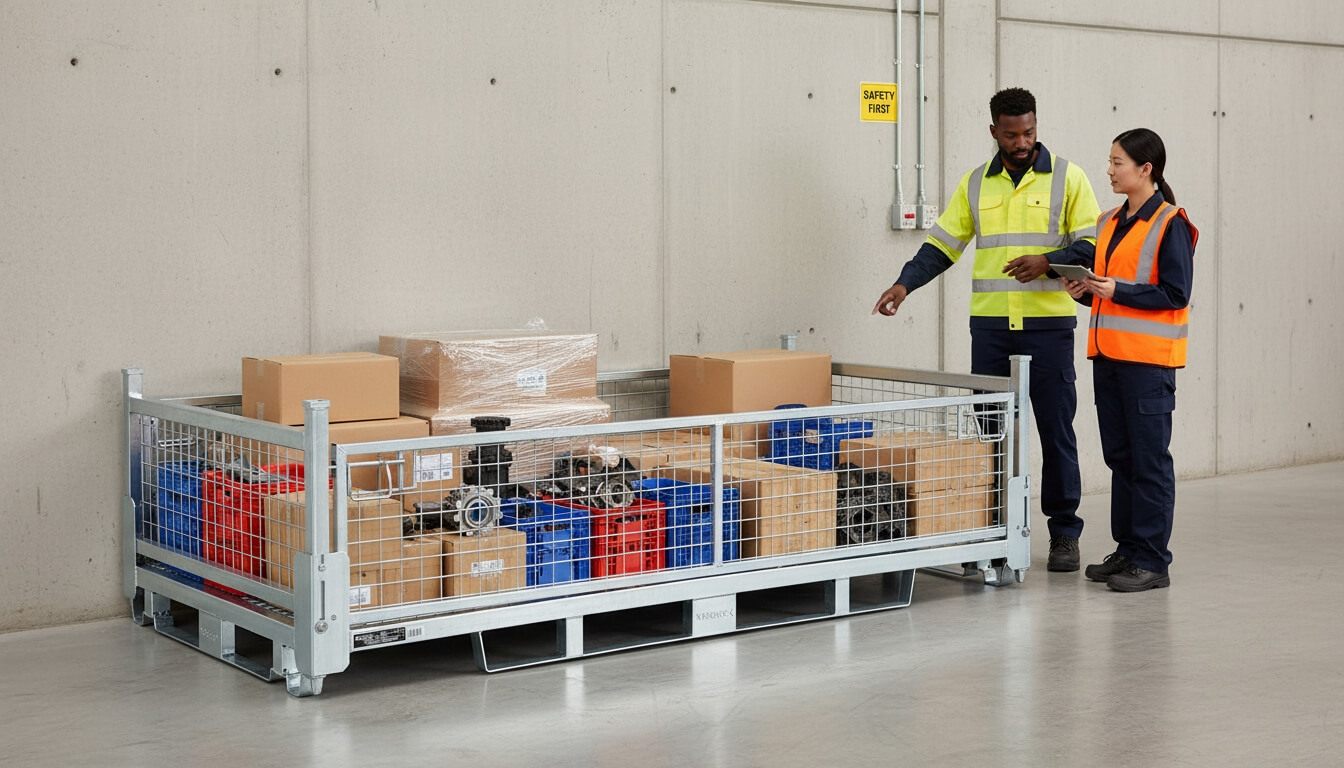 Low Height Double Width Storage Cage ↗ used for storing boxes and parts on a warehouse floor, with two staff inspecting inventory.
Low Height Double Width Storage Cage ↗ used for storing boxes and parts on a warehouse floor, with two staff inspecting inventory.
Where Are Stillage Cages Commonly Used?
Stillage cages have numerous applications across various industries, including manufacturing, retail, food storage, pharmaceuticals, and logistics. Let’s look at some common uses of these versatile storage units:
Storage and Transportation of Bulk Goods
Stillage cages are ideal for storing and transporting bulk items, such as automotive parts, electronics, or industrial equipment. The open design makes it easy to store items of varying shapes and sizes, ensuring that they remain organised and accessible.
Retail and Distribution
In retail and distribution centres, stillage cages are used to transport goods such as clothing, electronics, or non-perishable food. Their stackable design ensures maximum use of available space, helping to optimise storage in crowded warehouses or store rooms.
Food Storage
In the food industry, stillage cages are used to store products that require airflow, such as fruits and vegetables. The breathable design prevents the build-up of moisture and helps maintain the quality of the goods.
Pharmaceuticals
Pharmaceutical companies use stillage cages to safely store medical supplies and drugs. With their sturdy construction, these cages can carry heavy pharmaceutical containers, and in some cases, specialised cages can be used to prevent contamination.
Waste Management and Recycling
In manufacturing or construction sites, stillage cages are used to store scrap materials and other recyclables. This helps ensure that waste is collected and sorted in an organised manner, allowing for easier disposal or recycling.
Warehouse Operations
Stillage cages are commonly used in warehouses for bulk storage of items that need to be easily accessed or moved around. Whether it’s for raw materials or finished products, these cages are a practical solution for maintaining order and facilitating efficient inventory management.
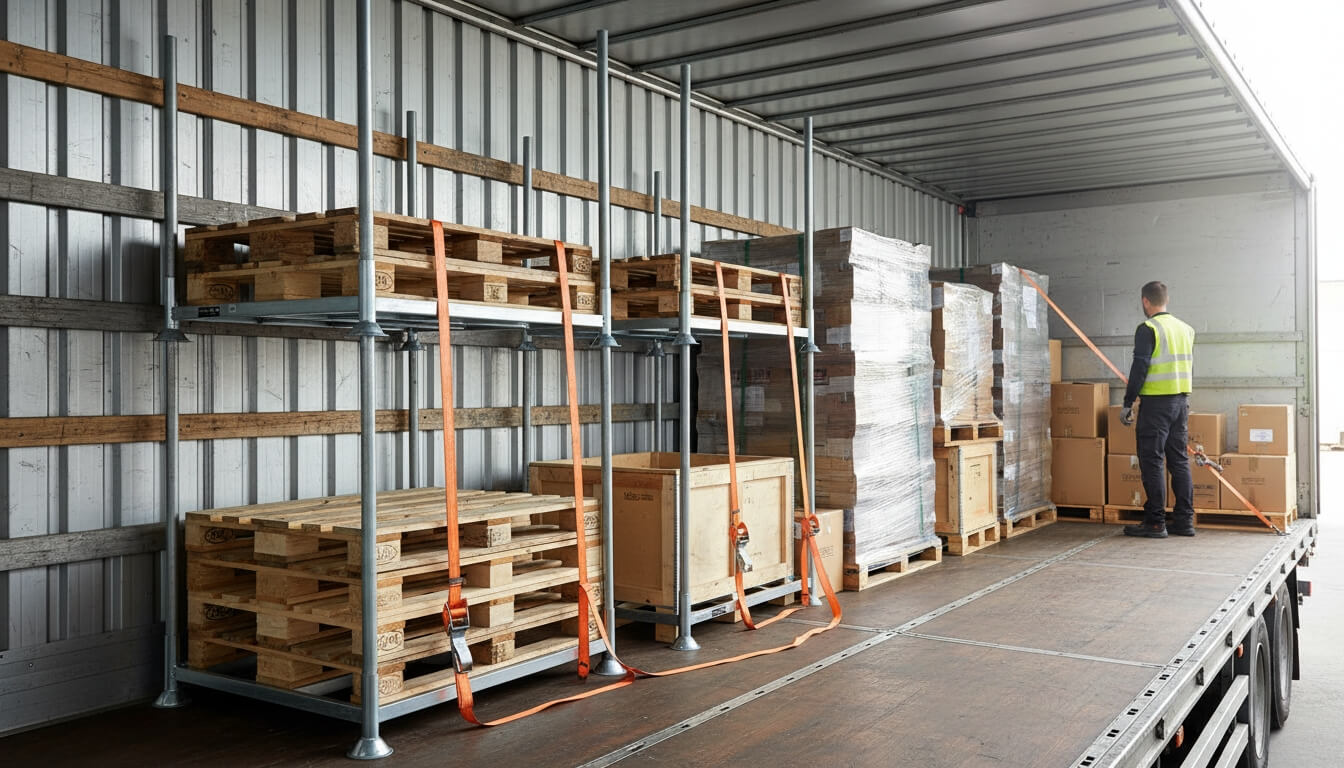 Stackable Stillage Cages ↗ secured inside a truck with pallets, crates, and boxes, as a worker fastens cargo straps for transport.
Stackable Stillage Cages ↗ secured inside a truck with pallets, crates, and boxes, as a worker fastens cargo straps for transport.
7 Key Benefits of Stillage Cages
The benefits of using stillage cages in a business or warehouse environment are significant. Here are some of the key advantages:
1. Increased Storage Efficiency
One of the primary benefits of stillage cages is their ability to maximise storage space. With stackable options, businesses can make full use of vertical storage, freeing up floor space and enabling more efficient use of warehouse or storage facility space. This helps reduce clutter and improves the overall organisation of goods.
2. Enhanced Safety
Stillage cages are designed with safety in mind. The robust construction ensures that stored items remain securely contained, reducing the risk of accidental damage or spillage. Additionally, many stillage cages are designed with secure locking mechanisms, offering extra security for valuable or sensitive items.
3. Improved Mobility
Stillage cages often come equipped with castor wheels, making them easy to move around. This feature is especially useful when it comes to shifting large volumes of goods across a warehouse or production floor. The wheels help streamline operations, saving time and reducing the strain on employees who might otherwise have to carry or drag heavy loads.
4. Durability and Longevity
Made from high-quality steel or reinforced wire mesh, stillage cages are built to last. Their sturdy construction makes them resistant to wear and tear, ensuring that they can handle heavy loads over extended periods of time. This durability makes them a cost-effective storage solution in the long run, as they don’t need frequent replacement.
5. Customisable and Versatile
Stillage cages can be customised to meet specific needs, such as dimensions, load-bearing capacities, or security features. Whether you need a basic cage for bulk storage or a more specialised one for delicate items, there is a stillage cage to suit your business requirements. Their versatility makes them suitable for a wide range of industries, from manufacturing to logistics.
6. Cost-Effectiveness
Compared to other storage solutions, stillage cages are relatively inexpensive. Their simple design, coupled with their durability, ensures that businesses get value for their investment. Furthermore, their ability to be folded or stacked makes them a space-efficient option that can save money on storage costs in the long term.
7. Better Inventory Management
With clear visibility and easy access to the stored items, stillage cages help businesses maintain better control over inventory. Workers can quickly identify and retrieve the items they need without having to search through disorganised piles of stock, which reduces handling time and increases overall productivity.
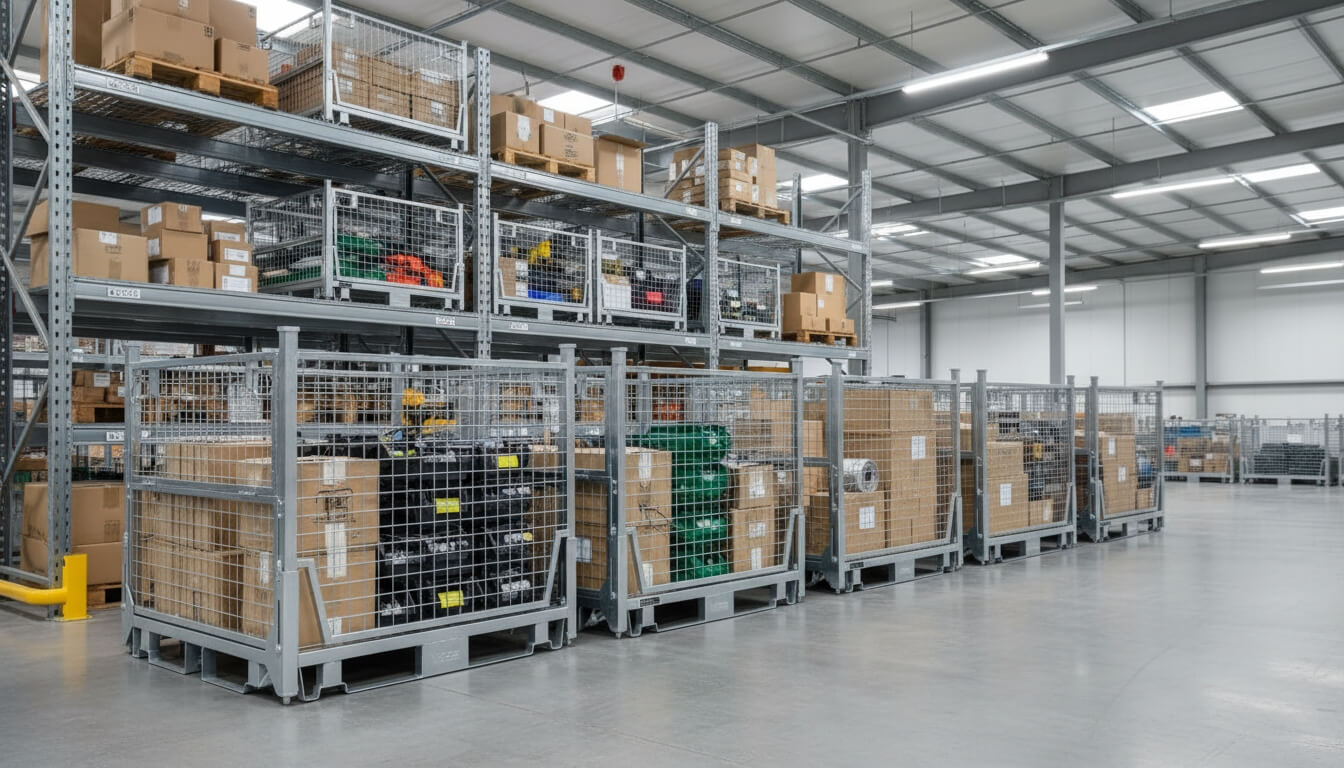 Collapsible & Stackable Stillage Cages ↗ arranged in a row on a warehouse floor, filled with boxed and palletised goods.
Collapsible & Stackable Stillage Cages ↗ arranged in a row on a warehouse floor, filled with boxed and palletised goods.
Why Stillage Cages Are a Smarter Choice for Modern Worksites
Stillage cages are an essential tool for businesses looking to streamline their storage and transportation processes. Whether you’re managing bulk goods, ensuring safe handling of pharmaceutical products, or improving the organisation of your warehouse, stillage cages offer a durable, space-efficient, and cost-effective solution.
By investing in stillage cages, businesses can enhance operational efficiency, improve safety, and optimise their storage space. With their versatility and range of applications, stillage cages are a smart choice for a wide variety of industries, from manufacturing to retail.
For businesses ready to upgrade their storage and handling systems, Verdex supplies a wide range of quality stillage cages available in stock across Australia.
































































































































 Trolleys & Hand Trucks
Trolleys & Hand Trucks Cage Trolleys
Cage Trolleys Cleaning Carts & Trolleys
Cleaning Carts & Trolleys Construction Trolleys
Construction Trolleys Custom Trolleys
Custom Trolleys Hand Trucks & Dollies
Hand Trucks & Dollies Laundry/Linen Trolleys
Laundry/Linen Trolleys Lifting Trolleys
Lifting Trolleys Order Picking Trolleys
Order Picking Trolleys Panel Cart Trolleys
Panel Cart Trolleys Platform Trolleys
Platform Trolleys Powered Trolleys
Powered Trolleys Shelf & Tiered Trolleys
Shelf & Tiered Trolleys Shopping Trolleys
Shopping Trolleys Stainless Steel Trolleys
Stainless Steel Trolleys Tool Trolleys
Tool Trolleys Utility & Service Carts
Utility & Service Carts Lifting & Handling Equipment
Lifting & Handling Equipment Forklift Attachments
Forklift Attachments Jib Attachments
Jib Attachments Lifting Hoists & Pallet Hooks
Lifting Hoists & Pallet Hooks Load Skates & Tow Tugs
Load Skates & Tow Tugs Manual Stackers & Lifters
Manual Stackers & Lifters Pallet Jacks
Pallet Jacks Pallet Lifters
Pallet Lifters Pallet Rotators & Dispenser
Pallet Rotators & Dispenser Powered Pallet Trucks & Electric Lifters
Powered Pallet Trucks & Electric Lifters Scissor Lift Trolleys and Tables
Scissor Lift Trolleys and Tables Conveyor Equipment
Conveyor Equipment Conveyor Frames & Stands
Conveyor Frames & Stands Roller & Skate Conveyors
Roller & Skate Conveyors Ladders & Access Equipment
Ladders & Access Equipment Container & Yard Ramps
Container & Yard Ramps Ladders & Step Stools
Ladders & Step Stools Work Platforms & Crane Cages
Work Platforms & Crane Cages Drum Handling Equipment
Drum Handling Equipment Drum Storage & Bunding
Drum Storage & Bunding Drum Trolleys & Lifters
Drum Trolleys & Lifters Forklift Drum Handling
Forklift Drum Handling Waste Handling & Bins
Waste Handling & Bins Bin Lifters & Tippers
Bin Lifters & Tippers Plastic Waste & Wheelie Bins
Plastic Waste & Wheelie Bins Steel Waste & Tipping Bins
Steel Waste & Tipping Bins Waste Carts
Waste Carts Dangerous Goods Storage & Spillage
Dangerous Goods Storage & Spillage Aerosol Cans Storage Cages
Aerosol Cans Storage Cages Bunded Pallets & Storage
Bunded Pallets & Storage Corrosive Goods Storage Cabinets
Corrosive Goods Storage Cabinets DG Storage & Trolleys
DG Storage & Trolleys Flammable Liquid Cabinets
Flammable Liquid Cabinets Forklift Gas Storage Cages
Forklift Gas Storage Cages Site Storage
Site Storage Spill Kits
Spill Kits Shelving & Storage Equipment
Shelving & Storage Equipment Stillage & Transport Cages
Stillage & Transport Cages 750 Series Cage Configurations
750 Series Cage Configurations Heavy Duty Cabinets
Heavy Duty Cabinets Heavy Duty Shelving
Heavy Duty Shelving Mega Bins & Pallets
Mega Bins & Pallets Packing & Workbenches
Packing & Workbenches Parts Trays & Stor-Pak Bins
Parts Trays & Stor-Pak Bins Pegboard & Louvre Panels
Pegboard & Louvre Panels Plastic Bins & Crates
Plastic Bins & Crates Plastic Handling Solutions Bins
Plastic Handling Solutions Bins Plastic Pallets
Plastic Pallets Stack & Nest Bins
Stack & Nest Bins Pallet Racking Accessories
Pallet Racking Accessories Workplace Equipment
Workplace Equipment Modular Workbenches
Modular Workbenches Electric Height-Adjustable Workbenches
Electric Height-Adjustable Workbenches Floor Matting
Floor Matting General Workplace Equipment
General Workplace Equipment Industrial Weighing Scales
Industrial Weighing Scales Packaging Machinery
Packaging Machinery Stationery Cupboards
Stationery Cupboards Storage and Stillage Cages
Storage and Stillage Cages Tool Trolleys
Tool Trolleys Tooling Cabinets
Tooling Cabinets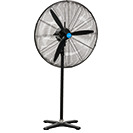 Workshop Fans and Coolers
Workshop Fans and Coolers Safety Barriers, PPE & Signage
Safety Barriers, PPE & Signage Barriers & Bollards
Barriers & Bollards First Aid Equipment
First Aid Equipment Gloves, Knives and PPE
Gloves, Knives and PPE Signage
Signage Cleaning & Site Supplies
Cleaning & Site Supplies Cleaning Equipment
Cleaning Equipment Cleaning Trolleys
Cleaning Trolleys Rubbish Bins
Rubbish Bins Signs & Traffic Supplies
Signs & Traffic Supplies Construction Equipment
Construction Equipment Construction Trolleys
Construction Trolleys Waste Handling
Waste Handling General Site Equipment
General Site Equipment Concrete Equipment
Concrete Equipment Site Storage
Site Storage Lifting Equipment
Lifting Equipment Verdex Specials
Verdex Specials
.jpg)
